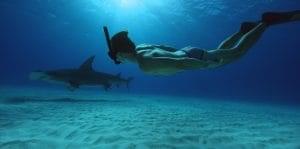
In 2007, environmental activist Rob Stewart produced and directed his first documentary film Sharkwater, which is credited for bringing awareness to the devastating practice of shark finning. Growing up Chinese, I’m well aware of the delicacy of shark fin soup, and while my naïve self considered it a dish akin to any seafood banquet, Stewart warned of its wasteful hunting by local and commercial fishermen, resulting in the near extinction of many breeds of shark.
Sharkwater is credited with influencing laws and public policy around the world, e.g., California no longer allows the sale, distribution, and possession of shark fins. Since 2007, more than 90 countries have banned shark finning and halted the trade of shark products.
Ten years later, Stewart returns with his follow-up feature, Sharkwater Extinction. The purpose of the documentary is two-fold. First, to update us on progress made plus progress that still needs to be made since the first film and then change the public’s view of sharks as the dangerous sea killers. We’re hunting around 150 million sharks each year. We can only account for 70 million sharks, which begs the question where are the other 80 million carcasses coming from?

“…update us on progress made plus progress that still needs to be made since the first film and then change the public’s view of sharks…”
Throughout the documentary, Stewart takes us to several international locations with a covert style of filmmaking. The first is Costa Rica, who over the past ten years had been the conversation leader. But change came with the election of Luis Guillermo Solis, who weakened the shark protection laws and essentially restarted Costa Rica’s shark finning trade.
Upon his arrival in Costa Rica, Stewart is notified that the government is on to him and he must “watch his back.” Stewart uncovers a private port, that is importing shark fins and with his drone camera discovers a meat drying room with hundreds of shark fins hanging.
From here, we go to Miami as Stewart hangs with a proud shark fisherman and films an afternoon excursion resulting in the catch-and-release of a shark. Then to Panama, a center for global trade in general, and visits a confiscation center storing illegal shark fins. He also visits Cabo Verde, Africa, where shark finning has been banned, but not the importation of shark fins.
While in Miami, Stewart utilizes DNA testing to calculate the amount of shark products used in pet food, fish filets, tuna salad, and livestock feed. He found 35% of shark products in pet food alone.

“…both inspiring and beautiful and makes an even stronger case for protecting shark since Sharkwater.”
While in Cat Island, Bahamas, we are taken underwater to swim with the majestic Oceanic White-Tipped Shark, who migrates to the Bahamas only once a year. With only scuba gear, an underwater camera, and sans shark cage, Stewart places himself and us in the middle of the school.
At the end, Stewart is in Key Largo to find the endangered Sawfish. It’s only found in the deep waters of the Atlantic, and he uses rebreather diving equipment which allows him to dive deeper and longer than with traditional scuba equipment. It is here that Rob Stewart’s life ends as he goes missing from the dive and rescue crews find his body days later.
Rob Stewart literally gave his life for Sharkwater Extinction. From the beginning, you see his passion for sharks and his dedication to saving them. His documentary is a testimony to that passion. It is both inspiring and beautiful and makes an even stronger case for protecting shark since Sharkwater. The message is heavy-handed, but his visual images are stunning to soften the blow. If there is a negative, it’s Stewart’s constant use of the word, “decimated.” I think he’s actually looking for a stronger word.
Sharkwater Extinction (2019) Directed by Rob Stewart.
8 out of 10 stars



What a courageous journey for which he gave his life. If not for seeing this film one may never know the majesty of sharks nor the cruelty of finning.